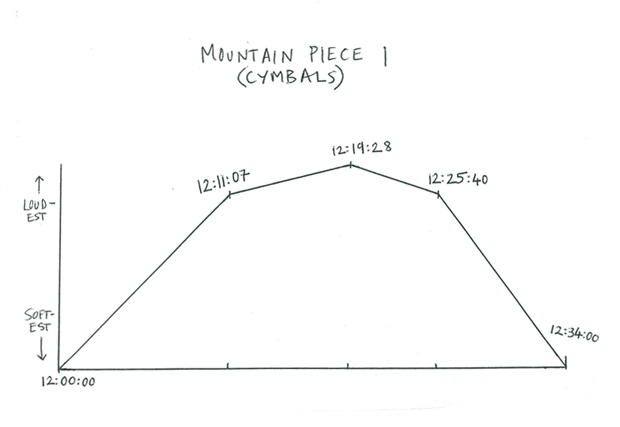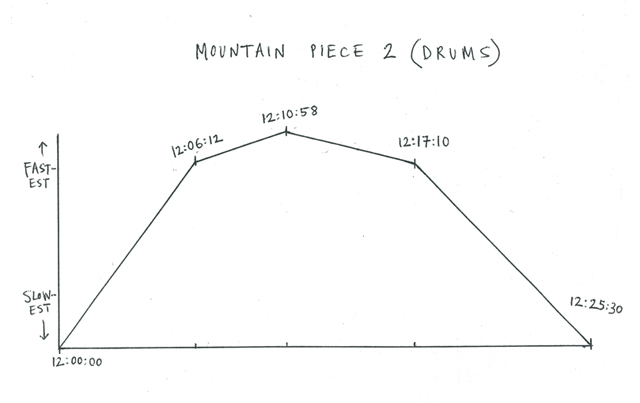
Tell me about the idea behind "Mountain Pieces."
Well, the two pieces have completely different sound sources, so they have very different timbral qualities, but both are realisations of the same basic gesture of rise and fall, like the visual profile of a mountain. The cymbal piece (Mountain Piece 1) realises this gesture as a rise and fall of volume, whereas the drum piece (Mountain Piece 2) realises it as a rise and fall of density. In this sense they are the same piece, only with differing particularities. The piece could be realised with pitch, speed, closeness of sound source, etc., and you could do it with violins, voices, or anything, for a minute, for an hour, for a week.

Mountain pieces are really happening all the time. I place a glass down on a table and I hear a mountain piece: an appearance, then disappearance of sound. The rate of rise and fall is not important, what is important is that something emerged, then receded - or in a more fundamental sense, that somethingness emerged, then receded.
The basic gesture of rise and fall is intrinsic to life itself because it is life. The emergence of something against the backdrop of nothing is the very situation of existence. Things appear from nothing, then recede again. The fact that we all follow this basic cycle means that we are all living out mountain pieces of our own.
You said the rate of rise and fall is not important. Why then does the piece take place over 30 minutes or more?
Even though we are surrounded by mountain pieces, we are not necessarily seeing this process or understanding its significance. In daily life, we tend to understand it only in terms of some other end. And perhaps in daily life we need to. We get so caught up in the meanings and functions we invest in things, that perhaps we stop finding wonder in the fact that the things simply are. It is in this state of wonder that we start seeing new meanings, making new connections - connections we initially missed because they didn't fit the anticipated pattern.
We need time to let go of these anticipations. These investments. To lose faith in them. We also need a focused space in which to do this. The space of "art" prepares us for a kind of deeper engagement with things; it can expose the perceptual opportunities we rarely seize in daily life.
Are there any new connections made specifically in the Mountain Pieces that you could talk about?
A specific connection which Mountain Piece 2 could potentially highlight is that between rhythm and texture. I can tell you the piece involves an increase in density, which intellectually we understand as rhythm speeding up. Yet when I hear it, at some point I become aware that what began as rhythm has somehow transformed into texture. Then later on the reverse occurs [see audio sample]. The two eclipse and emphasise one another seamlessly, playfully. By engaging with the process I discover this "play," and find a connection between two musical elements I would otherwise expect to remain separate.

© Alex Carpenter, 2004-2007